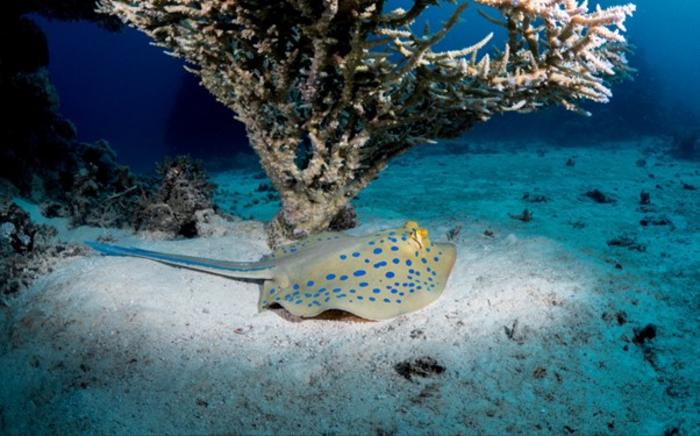Researchers have discovered the unique nanostructures responsible for the electric blue spots of the bluespotted ribbontail ray (Taeniura lymma), with possible applications for developing chemical-free colouration. The team are also conducting ongoing research into the equally enigmatic blue colouration of the blue shark (Prionace glauca).

Credit: Morgan Bennet Smith
Researchers have discovered the unique nanostructures responsible for the electric blue spots of the bluespotted ribbontail ray (Taeniura lymma), with possible applications for developing chemical-free colouration. The team are also conducting ongoing research into the equally enigmatic blue colouration of the blue shark (Prionace glauca).
Skin colouration plays a key role in organismal communication, providing life-critical visual clues that can warn, attract or camouflage. Bluespotted ribbontail rays possess striking electric blue spots on their skin, however, the biological processes that produced these electric blue spots was a mystery, until now.
“If you see blue in nature, you can almost be sure that it’s made by tissue nanostructures, not pigment,” says Mason Dean, Associate Professor of Comparative Anatomy at City University of Hong Kong (CityU). “Understanding animal structural colour is not just about optical physics but also the materials involved, how they’re finely organized in the tissue, and how the colour looks in the animal’s environment. To draw all those pieces together, we assembled a great team of disciplines from multiple countries, ending up with a surprising and fun solution to the stingray colour puzzle.”
Structural colours are produced by extremely small structures that manipulate light, rather than as a product of chemical pigments. “Blue colours are especially interesting because blue pigments are extremely rare, and nature often uses nanoscale structures to make blue,” says Viktoriia Kamska, a postdoc studying natural colouration mechanisms at CityU. “We’re particularly interested in ribbontail stingrays because, unlike most other structural colours, their blue colour doesn’t change when you look at them from different angles.”
The research team combined a variety of techniques to understand the skin architecture under different natural conditions. “To understand the fine-scale architecture of the skin, we used microcomputed tomography (micro-CT), scanning electron microscopy (SEM), and transmission electron microscopy (TEM),” says Dr Dean.
“We discovered that the blue colour is produced by unique skin cells, with a stable 3D arrangement of nanoscale spheres containing reflecting nanocrystals (like pearls suspended in a bubble tea),” says Amar Surapaneni, a postdoc with Mason Dean’s group until recently and now a visiting academic at Trinity College Dublin. “Because the size of the nanostructures and their spacing are a useful multiple of the wavelength of blue light, they tend to reflect blue wavelengths specifically.”
Interestingly, the team discovered that the unique “quasi-ordered” arrangement of the spheres helped to ensure the colour remained unchanged with viewing angle. “And to clean up any extraneous colours, a thick layer of melanin underneath the colour-producing cells absorbs all other colours, resulting in extremely bright blue skin,” says Dr Dean. “In the end, the two cell types are a great collaboration: the structural colour cells hone in on the blue colour, while the melanin pigment cells suppress other wavelengths, resulting in extremely bright blue skin.”
The team believe that this fascinating blue colouration is likely to provide camouflage benefits to the stingrays. “In water, blue penetrates deeper than any other colour, helping animals blend with their surroundings,” says Dr Dean. “Bright blue skin spots of stingrays do not change with viewing angle; therefore, they might have specific advantages in camouflage as the animal is swimming or quickly manoeuvring with undulating wings.”
The applications for this research currently being explored include bio-inspired pigment-less coloured materials. “We are pursuing collaborations with fellow researchers to develop flexible biomimetic structurally-coloured systems inspired by the soft nature of stingray skin for safe, chemical-free colours in textiles, flexible displays, screens, and sensors,” says Dr Dean.
As well as their work on stingrays, Dr Kamska and her team are also investigating the blue colouration of other rays and sharks, including the blue shark. “Despite the name ‘blue shark’ and its ecological aspects being well studied, no one still knows how the blue colour is produced on its skin,” says Dr Kamska. “Preliminary results demonstrate that this coloration mechanism is different from the stingray’s – but just like the stingray, we need to try different combinations of fine imaging tools and address multiple related disciplines in optics, material, and biological science.”
This research was published in Advanced Optical Materials titled “Ribbontail Stingray Skin Employs a Core–Shelf Photonic Glass Ultrastructure to Make Blue Structural Color”.
There is also a forthcoming article in Frontiers in Cell and Developmental Biology, titled “Intermediate filaments spatially organize intracellular nanostructures to produce the bright structural blue of ribbontail stingrays across ontogeny.”
The research is supported by the University Grant Committee with the General Research Fund at the City University of Hong Kong.
This research is being presented at the Society for Experimental Biology Annual Conference in Prague on the 2-5 July 2024.
Journal
Advanced Optical Materials
DOI
10.1002/adom.202301909
Method of Research
Experimental study
Subject of Research
Animals
Article Title
Ribbontail Stingray Skin Employs a Core–Shelf Photonic Glass Ultrastructure to Make Blue Structural Color
Article Publication Date
1-Mar-2024




